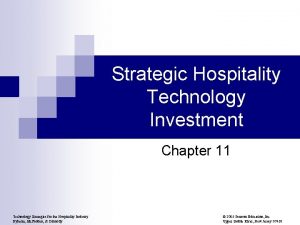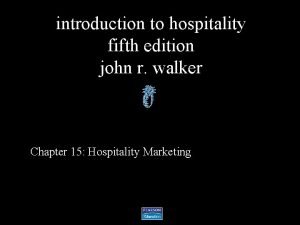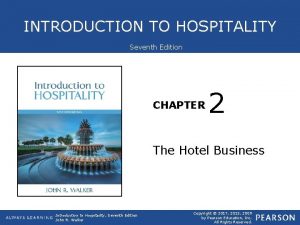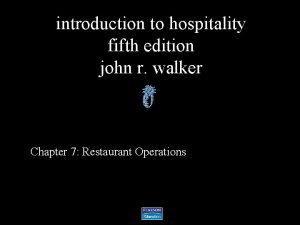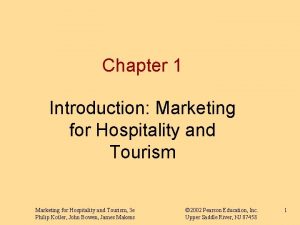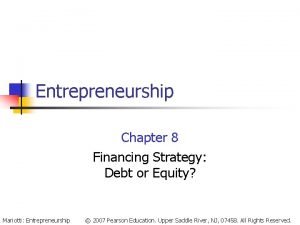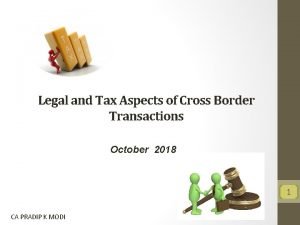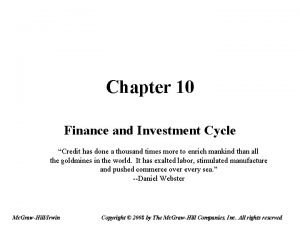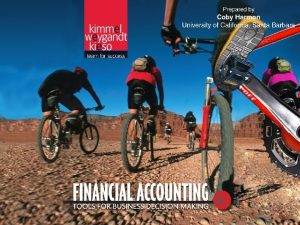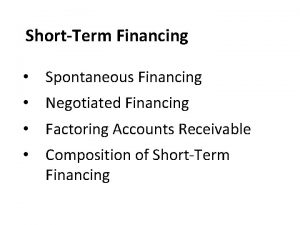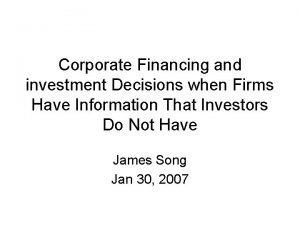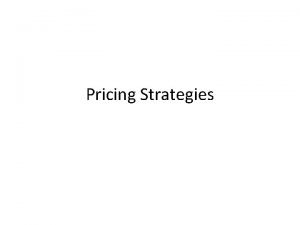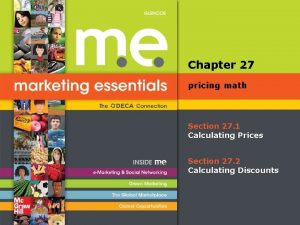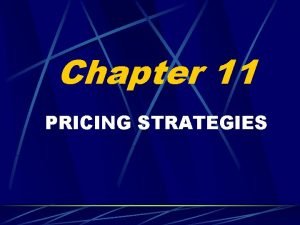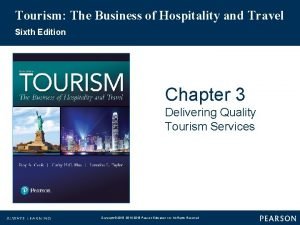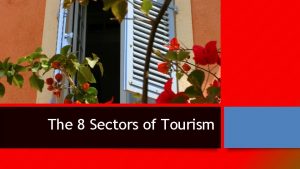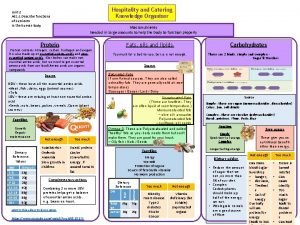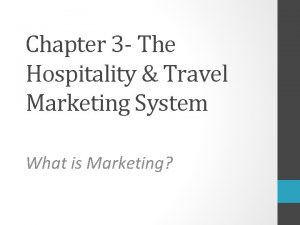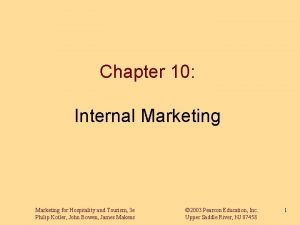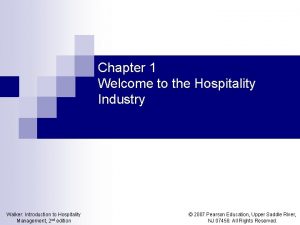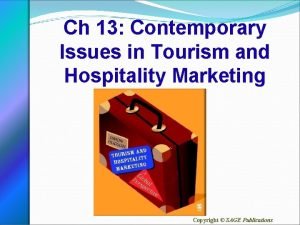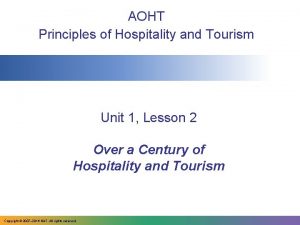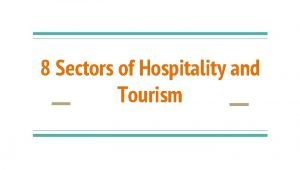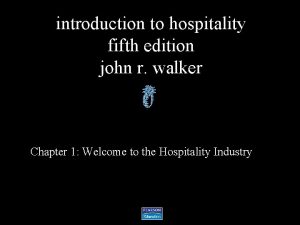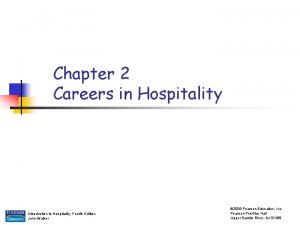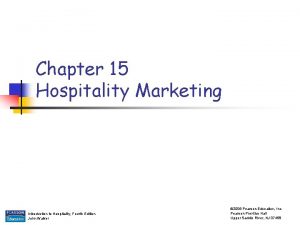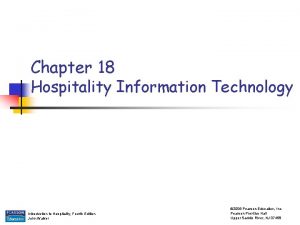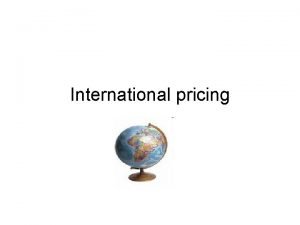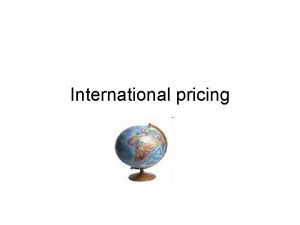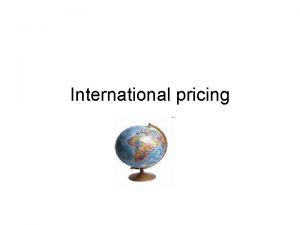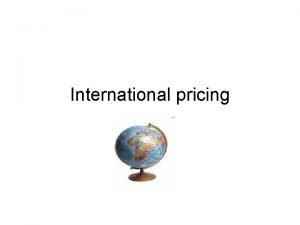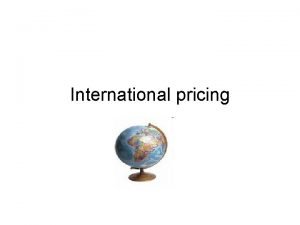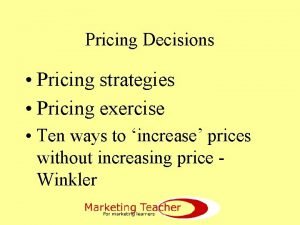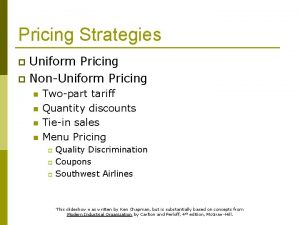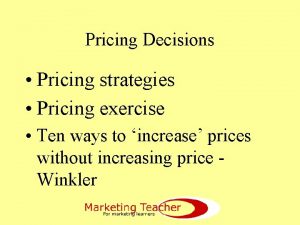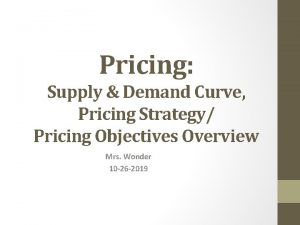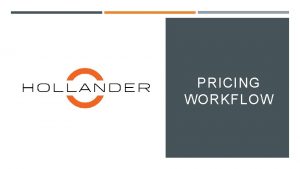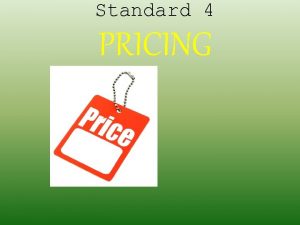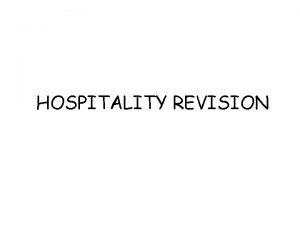INTRODUCTION TO HOSPITALITY Chapter 7 PRICING AND FINANCING





































- Slides: 37

INTRODUCTION TO HOSPITALITY Chapter 7 PRICING AND FINANCING

Objectives: o o 7. 1 Hotel Pricing Strategies 7. 2 Restaurant and Tourism Pricing Strategies 7. 3 Purchasing Strategies 7. 4 Financing Various Forms of Ownership

The Father of Franchising o Kemmons Wilson n Founder of Holiday Inn Built the first few hotels then sold the idea of licensing the name and standards of Holiday Inn (Franchising) Allowed individuals to own and operate their own lodging business using the Holiday Inn logo and standards

Kemmons Wilson

Types of Room Rates o o o The hotel business sells room space If a room is empty for one night, the opportunity to make money is gone… The price of a room depends on several factors n n Location & type of property Services & amenities Target market & economic conditions Supply & demand for rooms

Season Price o o Peak Season: when demand is high, rates are high Shoulder Season: when demand is low and rates are low

Room Prices o Rack Rate: published rates considered to be standard, which are prices published in travel directories or quoted to walk-in guest- the term “rack rate” is considered hotel jargon and should not be used when quoting rates to a potential customer

Room Prices o Corporate or Commercial Rate: Usually 1015% less than the rack rate, given to companies or business that are frequent customers

Room Prices o Group Rates: available for large groups that reserve ten or more rooms for a conference or special event-often have advance deposits, and repeat sales for the hotel

Room Prices o Government Rates: available for school, state, federal government employees, usually based on per diem (daily expense allowance)

Room Prices o Senior Rates: for guests over 55, large target market, usually 10 -15% discount

Room Prices o Specialty Rates: given for several reasons n n Airline Rates: available on properties located close to airports, airline crews may receive up to 50% discount- stranded flyers due to weather usually get big discounts Club or Frequent Guest Discounts: given to customers that return on a regular basis, usually given during slow seasons Employee Rates: given to employees from the same hotel corporation, usually 50% discount Travel-agent Rates: offered to agents to build strong partnerships and for recommending the property to customers

Determining Room Rates o Guideline for Rates: $1 for every $1, 000 of construction costs and per-room investment Example: if a hotel costs $200, 000 per room to build the average room rate should be $200

Hubbart Formula o Determines profitable room rates using specific information What it cost to run the hotel. Money a hotel hopes to make. Money earned from other areas such as gift shops, restaurants, movies Operating Expenses + Desired Return on Investment – Other income = Average room rate Projected room sales Forecast of sales taken from past sales, trends, & research $9, 000 + $6, 000 - $900, 000 100, 000 = $141 (average room rate)

Breaking Even Point o o Where revenue, the money from sales, equals the cost of running the property (any money taken in over the break even point is profit) Successful hotel managers know how many rooms per night must be sold in order to reach the breakeven point

Breaking Even Point o To determine the breakeven point first n n n Determine the Fixed Costs (expenses that remain the same from month to month) Determine the Variable Costs (costs that change from month to month as the number of rooms occupied change-example: housekeeping) Divide the Fixed Costs by the Average Room Rate less the Variable Costs (formula)

Breakeven Point Formula Fixed Costs. = Avg. Room Rate – Variable Costs $200, 000 (fixed cost per month) Breakeven point = 2, 564 rooms per month must be sold to $141 (average room rate) - $63 (variable cost per room) break even

Occupancy Rate o o The percentage that expresses the ratio of total rooms sold to total rooms available per month To determine the occupancy rate necessary to break even for a given month use the following formula

Occupancy Rate Formula o. First find the number of rooms available per month Rooms available X each day 134 rooms o. Then X Number of days in a month 30 days Rooms available = per month = 4, 020 rooms available determine the occupancy rate to break even Rooms to sell to break even = Occupancy Rate = 0. 6378 or 64% Rooms available per month 2, 564 4, 020

Yield Management o o o Prices in the lodging industry change constantly Management must continually analyze rates, predict future demand, and adjust room rates accordingly to maximize profits The practice of evaluating demand setting prices to result in maximum revenue is known as called Yield Management

Promotions & Psychological Pricing o o To increase business, hotels often offer promotional packages with special prices to increase business during slow seasons Hotels often avoid even numbers when setting prices n Example: Psychological Pricing$59. 99 instead of $60. 00 - The $59 price sounds lower than $60

Restaurant &Tourism Pricing Strategies o o Many factors are involved in the competitive process of assigning a price to a meal You must figure cost of sales (formula) n o o Opening inventory + Purchased Inventory -Closing inventory = Cost of Sales Figure in direct operating expenses such as cost of flatware, glasses, dishes, kitchen grills, ovens, pots, pans etc. Figure in indirect operating expenses such as advertising, utilities, administrative costs, repairs, payroll, rent or mortgage, franchise fees, taxes

The High Cost of Flying o o o Airline tickets are some of the most negotiable products in the travel business Regular air service flights will arrive at their destinations-whether the plane is full or not A seat on an airplane is like a hotel room-it is perishable-if you don’t sell it today-you miss the opportunity to make money on it

Revenue Management o o Policies and methods used to set airline prices are based on supply and demand of the product The price of an airline ticket includes n Operating expenses such as salaries, fuel, maintenance of aircraft, equipment costs, passenger food, advertising, travel agent commissions, communications, insurances, taxes, landing fees, cargo taxes, international departure fees, & fuel taxes

Purchasing Strategies for Hotels and Restaurants o o Purchasing: selecting and obtaining goods and services from vendors (the companies that supply goods and services) Purchasing involves contacting vendors, gathering bids or quotes for prices, evaluating products and service value, developing ordering procedures, receiving merchandise, storing and issuing supplies, re-ordering, and keeping an accurate record of transactions

Receiving Goods and Services o o o Purchases must be carefully tracked and handled when they arrive Most receiving areas are part of or next to the purchasing department Orders are received and verified then packing slips are turned over the management and compared to invoices to make sure what was billed was actually received

Storing, Issuing and Reordering Supplies o o o Supplies are storied in secure areas Inventory logs show when products are taken out of or put into storage Food and beverage items are kept in dry storage where temperature is between 40 -80 degrees. An on going inventory of items is called a perpetual inventory A physical inventory is when management periodically physically counts items in storage

Storing, Issuing and Reordering Supplies o o Many supply items should be stored in a way to ensure that the products already there are used before items that just arrive This method of using products in the order in which they were received is known as first-in/first-out or FIFO (usually new items are stocked behind other similar products or rotated left to right) Shelf-life is the amount of time a product can remain in storage before it looses its value (ie. Date on milk) Hotels and restaurants often set a reorder point for certain products, which establishes a par level for quantities of products in inventory

Financing Various Forms of Ownership o Hotel and Restaurant Ownership n Franchise: Legal agreement to operate a business under the name of an already established business trade name o o Franchisee pays a royalty and an initial fee for the right to own a business and management system under the name of the recognized company (instant brand recognition, national advertising, training, site selection, operating is provided by franchisor) Franchisor lends the trademark, the trade name, and often the business system to the franchisee,

Hotel and Restaurant Ownership About 76% Of all fast food restaurants are franchises

Hotel and Restaurant Ownership o o Sole Proprietorship: owing and operating a business, accepting all legal and financial responsibilities, accepts all the risks, getting all the profit, no partner Disadvantage: all liabilities, no one to share the work involved

Hotel and Restaurant Ownership o o o Partnership: When two or more people own a business and share the risks, responsibilities, and profits, usually with one general partner (who will have unlimited liability and usually manages the business) sometimes all partners are named as general partners Advantage: easy to set up, partners have full control Disadvantage: partners may soon disagree on management of business

Hotel and Restaurant Ownership o Corporation: registered or chartered by state and is owned by stockholders, must have a board of directors, chief executive officer and chief financial officer, corporation management runs the business, profits go to the stock holders

Corporation Names o o o Corporations may own several Brand Names n Example: Hilton, Sheraton, Marriott Cendant Corporation owns e different hotel brands n Days Inn, Ramada, Super 8, Wingate, Villager, etc Major corporations also own restaurant chains n Tricon Global owns: KFC, Pizza Hut, Taco Bell n Brinker owns: Chili’s, Macaroni Grill and Cozymel’s

Financing Sources o o The money necessary to run a business is known as capital (which includes money, real estate, equipment, and tools needed to produce goods and services to sell) Debt Capital: when you borrow money from commercial finance companies or banks for your business and have to pay it back with interest

Financing Sources o o Line of Credit: usually given by banks to businesses to allow them to have money when needed for operations Banks don’t take as big of a risk as do commercial finance companies, however, you have to pay finance companies higher rates of interest for your borrowed money

Financing Sources o Equity Capital: money loaned to a business for part ownership, or equity in the business, also called risk capital because of the risk taken by the one that makes the loan n Example: personal savings, private investors, partners, friends, relatives, venture capitalists
 Tourism industry definition
Tourism industry definition Introduction to strategic hospitality technology investment
Introduction to strategic hospitality technology investment Food and beverage directors expect a pour cost of
Food and beverage directors expect a pour cost of Introduction to hospitality 7th edition
Introduction to hospitality 7th edition Introduction to hospitality 7th edition
Introduction to hospitality 7th edition Tourism the business of hospitality and travel 5th edition
Tourism the business of hospitality and travel 5th edition Marketing for hospitality and tourism pearson
Marketing for hospitality and tourism pearson John r walker introduction to hospitality management
John r walker introduction to hospitality management Marketing for hospitality and tourism 7th edition ppt
Marketing for hospitality and tourism 7th edition ppt New money spent by tourists and then respent by hotels
New money spent by tourists and then respent by hotels Chapter 8 financing a business
Chapter 8 financing a business Philippe thiel
Philippe thiel Cross boarder transactions
Cross boarder transactions Financing and investing cycle
Financing and investing cycle Tax payable in cash flow statement
Tax payable in cash flow statement Operating investing and financing activities
Operating investing and financing activities Spontaneous financing formula
Spontaneous financing formula Pecking order theory
Pecking order theory Chapter 26 pricing strategies answer key
Chapter 26 pricing strategies answer key Chapter 27 pricing math
Chapter 27 pricing math Segmented pricing
Segmented pricing Chapter 26 pricing strategies
Chapter 26 pricing strategies Wjec hospitality and catering unit 2 examples
Wjec hospitality and catering unit 2 examples Wjec hospitality and catering
Wjec hospitality and catering Tourism the business of hospitality and travel
Tourism the business of hospitality and travel Sectors of tourism
Sectors of tourism Marketing for hospitality and tourism 7th edition
Marketing for hospitality and tourism 7th edition Hospitality and tourism final exam
Hospitality and tourism final exam Ac 2.1 hospitality and catering
Ac 2.1 hospitality and catering Hospitality & travel marketing
Hospitality & travel marketing Internal marketing in tourism
Internal marketing in tourism Chapter 1 welcome to the industry
Chapter 1 welcome to the industry Contemporary issues in hospitality industry
Contemporary issues in hospitality industry Aoht principles of hospitality and tourism
Aoht principles of hospitality and tourism Sectors of hospitality industry
Sectors of hospitality industry Wjec level 1/2 hospitality and catering
Wjec level 1/2 hospitality and catering The interrelated nature of hospitality, travel and tourism
The interrelated nature of hospitality, travel and tourism Hospitality and catering revision
Hospitality and catering revision

